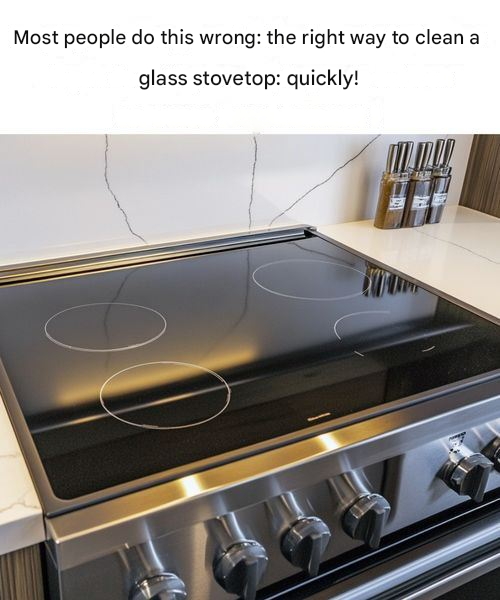4. Neglecting regular maintenance.
Many people wait until their cooktop is visibly dirty to clean it. Unfortunately, by this point, food particles and grease may have hardened, making them much harder to remove. Regular cleaning prevents buildup and helps keep your cooktop in pristine condition.
The right way to clean a glass stovetop: the baking soda and vinegar method.
If you're looking for a quick and easy way to clean your glass stovetop, my favorite method is to use two simple household products: baking soda and white vinegar. This method is gentle on the glass but effective against stains, ensuring a deep clean without the risk of damaging it. Here's how:
What you'll need:
Baking soda
White vinegar
Spray bottle
Microfiber cloth or soft sponge
Razor blade scraper (optional, for tough stains)
Warm water
Protective gloves (optional)
Step-by-step instructions:
1. Make sure the hob is cool
Always make sure your hob is completely cool before starting the cleaning process. This prevents any risk of burns and ensures the cleaning solution doesn't spray and leave streaks.
2. Remove debris.
Wipe the cooktop with a dry microfiber cloth to remove debris, crumbs, and dust. This prevents the baking soda and vinegar mixture from becoming grainy and scratching the surface.
3. Spray with vinegar.
Fill a spray bottle with white vinegar and spray the entire stovetop generously. Vinegar is a natural degreaser that helps remove greasy residue, making it easier to remove burnt-on food particles.
4. Sprinkle baking soda.
Lightly sprinkle baking soda over the vinegar-covered surface. The two ingredients will fizz upon contact, helping to loosen and lift away stubborn stains without damaging the glass.
5. Let it sit.
Let the vinegar and baking soda mixture sit for about 15 minutes. During this time, the mixture will soften and loosen stubborn stains, reducing the need for vigorous scrubbing.
6. Wipe.
After 15 minutes, use a damp microfiber cloth or soft sponge to gently wipe away the baking soda and vinegar mixture. The stains should come off easily, leaving your stovetop clean and streak-free. Rinse and wring out the cloth if necessary to prevent the residue from spreading.
7. Use a razor blade scraper for stubborn stains (optional).
If you have particularly stubborn stains that won't come off with baking soda and vinegar, gently use a razor blade scraper at a slight angle to gently lift the residue. Be sure to keep the blade flat against the glass to avoid scratching it.
8. Final Wipe:
Once all stains are removed, wipe one last time with a clean, damp cloth to remove any residue. Finish by drying with a dry microfiber cloth to polish the surface and restore its shine.
Why this method works:
The mild abrasiveness of baking soda: Baking soda is mildly abrasive, making it ideal for cleaning tough stains without scratching the glass surface. It also neutralizes odors and helps loosen dirt.
The grease-cutting power of vinegar: Vinegar is a powerful natural degreaser that breaks down cooking oils and fats, making it easier to remove grease and grime.
No harsh chemicals: This method uses natural ingredients that are safe for your family, your stove, and the environment, providing effective cleaning without harsh chemicals or fumes.
Regular maintenance tips for a spotless glass cooktop.
Keeping your glass cooktop in perfect condition requires regular maintenance. Here are some simple maintenance tips to keep your cooktop looking its best:
1. Wipe up spills immediately.
As soon as your stove cools down, wipe up any spills or splashes with a damp cloth. This prevents stains from setting in and reduces the need for intensive cleaning later.
2. Clean weekly.
Even if your cooktop looks clean, it's a good idea to give it a quick wipe with a damp cloth and vinegar once a week. This prevents dirt buildup and keeps your cooktop looking shiny.
Continued on next page
